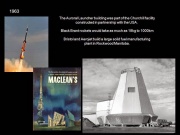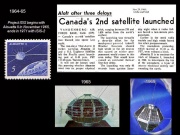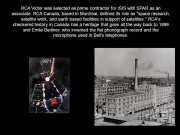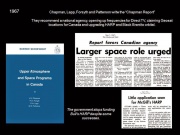100 Years of Aerospace History in Canada: From McCurdy to Hadfield Part 8 by Robert Godwin
From The Space Library
Happy Times, Planning for the Future, HARP Defunded and The Chapman Report
As early as September 1963 a 3000 acre solid fuel rocket plant had been established at Rockwood Manitoba for supplying rocket propellant to the Churchill launch site. The site was built by Bristol and Aerojet-General for $2M.[i] USAF expertise and money flowed into Churchill where a dedicated team of research scientists continued to launch ever more complex and sophisticated payloads into the upper atmosphere.
The Canadian built Black Brant IV would ultimately fly an 18 kg payload to 1000 km and it was determined that given a small increase in budget it could have quickly been upgraded to orbital capability. A large "auroral" launch building was completed at the Churchill site and allowed the scientists to work on their payload while sheltered from the climate. Black Brant would soon be competing with Bull's HARP for the limited Canadian government funds available.
Gerald Bull used the media and all of his many intellectual assets to keep HARP's money flowing. Eventually by the summer of 1964 he managed to effectively embarrass the Canadian government into matching the US Army funding for HARP.[ii] At this point the second HARP test site began construction in Highwater, Quebec.
Later in 1964 the Canadian government signed an agreement with the United States to place three more satellites into space, all from the launch site at Vandenberg. This project became known as the International Satellites for Ionospheric Studies (ISIS) and was successfully conducted over the ensuing seven years.
The first ISIS satellite was named Alouette II and was launched November 29th 1965. RCA Victor was selected as prime contractor with SPAR as an associate. RCA Canada, based in Montreal, defined its role as "space research, satellite work, and earth based facilities in support of satellites." RCA's checkered history in Canada has a heritage that stretched all the way back to 1899 and Emile Berliner, who had invented the flat phonograph record and the microphone used in Bell's telephones.
Montreal became a nexus for electronics and communications technology, in part because Marconi also set up the Canadian Marconi Company there in 1903. Berliner was bought out in 1924 by Victor Talking Machine Company which in turn was bought out in 1929 by the quasi-government Radio Corporation of America.[iii] The fight over who would control trans-Atlantic communications, Britain or America, certainly spurred the development of the robust electronics industry in Montreal. The century-long battle evolved from undersea cables to radio and ultimately to satellites. In 1977 RCA's Government and Commercial Systems Division was purchased by SPAR.[iv] Berliner's factory built in 1920 on Rue Lenoir in Montreal played a major role until RCA closed it down in the 1980s.
In May 1966 while on a trip to France Dr Lapp was telephoned by John Chapman who also happened to be in France at that moment. Chapman asked Lapp to meet him to discuss a new study group ordered by Dr Omond Solandt of the Science Council of Canada (SCC). This study group was charged by the SCC to come up with proposals for the future course of Canada's space program, specifically towards developing policy for space communications, space and upper atmosphere research, and how these activities should be organized and funded.[v]
Lapp and Chapman spent that evening cruising down the Seine while discussing their plans for the future. Lapp later recalled that Chapman entered a singing contest with a group of "lively Australians" and won the day with a rousing version of Alouette. The only time he claims he ever saw Chapman "let his hair down."
The SCC study group included Chapman, Lapp, Gordon Patterson of the University of Toronto and Peter Forsyth of the University of Western Ontario. Patterson, a U of T graduate and ex-member of Kurt Stehling's rocket club, had distinguished himself in the 1930s as scientific officer at the Royal Aircraft Establishment at Farnborough. Chapman's SCC group held meetings in eleven cities across Canada for four months in 1966 before heading south to meet with Robert Seamans at NASA and then travelling as far afield as Europe and Japan for consultations.[vi]
"The final report was written by individual members of the Study Group and many others from across the country. I wrote Part III, HARP-McGill, the section dealing with Dr Gerry Bull and his big guns, and the section on the Black Brant program," Dr. Phil Lapp.[vii]
By this time Black Brant and HARP were the two biggest projects in the Canadian aerospace budget. Many contractors around the country were involved, including Heroux of Quebec who made various probes for HARP and later made the legs for the Apollo Lunar Module.
The SCC sponsored report appeared in February 1967 under the title Upper Atmosphere and Space Programs in Canada but soon became known as simply The Chapman Report since that was the way it was described in the follow up from the SCC which was entitled A Space Program for Canada.
The most notable recommendation from the group was the formation of a national space agency. This proposed new organization would be both a national advisory body and contracting agency. This was consistent with a recommendation which had been put forth by The Royal Commission on Government Organization as early as January 1963. Input from all parts of industry and academia considered the consolidation of the national effort as the most useful solution to many of the problems inherent in the various programs underway. Despite this, that particular recommendation would still not be implemented for another 22 years.
One of the most problematic issues was the discrepancy between public and private budgets. At the time of the report government researchers in Canada received ten times the compensation that their industry peers received.
And while Universities definitely wanted a national governing space body, they didn't see any use for Gerald Bull's HARP. Most of the experiments that were planned simply couldn't withstand the shock of a HARP launch. Despite Dr Lapp's opinion that HARP could serve a meaningful purpose, the budget share that Bull had carved out from the Canadian government was simply too high.
Other important recommendations from Chapman's group included staking a claim to GEO locations between 75 degrees W and 115 degrees W for Canadian communications satellites. They also recommended that the government allocate the same percentage of the GNP to space as the United States (0.1%). Despite lower amounts of GNP allocated in other space-faring countries the Study Group felt that living so close to the United States would create too much temptation for more of Canada's top scientific minds to move south in search of bigger budgets.
The Churchill Research Range and the Black Brant were deemed by the Study Group to be good enough for orbital launches. They recommended that Canada should take over full responsibility for CRR (which they did until closing it in 1985) and that by strapping multiple Black Brants together or modifying the Scout launcher, or even giving Bull more money, Canada could quickly develop its own orbital launch capability. None of these recommendations were followed.
Other suggestions included building a robust satellite industry; changing the allocation of certain frequencies to allow for the possibility of direct satellite television transmissions; a coordinated effort to organise the different university programs; and if necessary in the future, encouraging life science researchers to cooperate with foreign programs.
However, the three most notable recommendations that Olandt took to the Minister were, a national agency, the need for comm-sats by 1971 and a Canadian satellite launch capability. Of the three, the first two were eventually implemented.
The three sections of the Chapman Report were broken down into history, treaties and Gerald Bull's HARP. Despite the special attention given to Bull's mega-project, by November 1967 the tide had begun to turn against HARP.
After the Chapman Report was published Canada's fragmented space efforts continued much as before, with the notable exception of Bull's HARP, which was deprived of Canadian funding at the end of June 1967.
Footnotes
[i] Globe and Mail Sep 20 1963
[ii] Ibid. July 16 1964
[iii] http://www.berliner.montreal.museum/site/enberlinerplus.html
[iv] Phil Lapp Memoir pg 227
[v] Ibid. Pg 178
[vi] Ibid. Pg 178
[vii] Ibid. Pg 179




